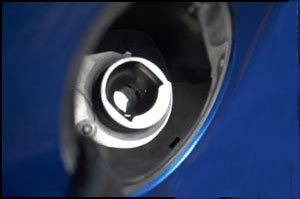Even if the price of petrol at the pump really stinks, at least your hands won’t after you have finished filling up your car.
All thanks to engineers at Ford who have developed the so-called Easy Fuel capless fuel-filler system, a novel design that uses an integrated spring-loaded flapper door to eliminate the need for a fuel tank screw cap.
Ford’s plans to offer the Easy Fuel system as standard equipment across the Ford, Lincoln and Mercury product lineups. It will be launched on the 2008 Ford Explorer and Mercury Mountaineer and will be joined by the all-new 2009 Ford Flex, Ford F-150 and Lincoln MKS this summer.
When Ford measured customer response to the system in focus group studies, 75 percent of women and 67 percent of men expressed a particularly high interest regardless of demographic or vehicle segment. ‘People noted that it was very useful and a time saver and considered the fact that their hands didn’t get dirty to be a major attraction,’ said Pamela Wylie, Ford technology planning manager.
According to Annette Huebner, a Ford product planning analyst, Easy Fuel has produced several unexpected benefits that customers may also appreciate.
‘With Easy Fuel, you don’t have to worry about that dangling petrol cap scratching your vehicle’s paint anymore,’ she noted. In addition, customers who have arthritis don’t have to struggle to open or tighten a cap every time they’re at the pump.
Here’s how it works: the spring-loaded flapper door is held closed by two latches that can only be released by a standard-size unleaded fuel nozzle. When the proper nozzle is inserted into the filler neck of the system, the latches release, and the nozzle pushes the spring-loaded flapper door to the open position. When the nozzle is removed, the flapper door is automatically forced closed by the spring.
The fuel filler pipe is then completely sealed, which prevents fuel vapour from escaping and helps reduce evaporative emissions.

‘Every time a fuel cap is either lost or not screwed on properly, that equates to evaporative emissions entering the environment,’ said Brian Aitken, a Ford fuel systems supervisor. ‘With Easy Fuel, these scenarios are no longer a problem.’
The new system also has a patented mis-fuelling inhibitor to reduce improper fuelling and siphoning.
The inhibitor consists of a fuel nozzle detector that guides the nozzle to the opening. If a nozzle or foreign tube of a different size - a diesel nozzle or plastic hose, for example - is placed in the filler neck of a gasoline-powered vehicle, the latches will not release. For a diesel-powered vehicle, the inhibitor will keep out the smaller gasoline nozzles.
To protect the fuel filler neck from dirt, dust and debris, Easy Fuel relies on a flexible rubber seal in the body housing. The system also comes with a plastic funnel, which is stored with a vehicle’s tyre changing kit, in case someone runs out of fuel and needs to add a gallon or two from a portable container.
‘Because fuel cans are not standardised in terms of their nozzle, we needed to make sure customers could easily get fuel into the system if they ran out,’ said Aitken. The funnel is the same diameter as an unleaded fuel pump nozzle for a petrol-powered vehicle.




April 1886: the Brunkebergs tunnel
First ever example of a ground source heat pump?